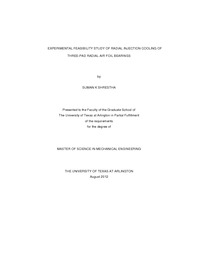
ATTENTION: The works hosted here are being migrated to a new repository that will consolidate resources, improve discoverability, and better show UTA's research impact on the global community. We will update authors as the migration progresses. Please see MavMatrix for more information.
Show simple item record
| dc.contributor.author | Shrestha, Suman K. | en_US |
| dc.date.accessioned | 2012-07-25T19:07:43Z | |
| dc.date.available | 2012-07-25T19:07:43Z | |
| dc.date.issued | 2012-07-25 | |
| dc.date.submitted | January 2012 | en_US |
| dc.identifier.other | DISS-11759 | en_US |
| dc.identifier.uri | http://hdl.handle.net/10106/11019 | |
| dc.description.abstract | Air foil bearings use ambient air as a lubricant allowing environment-friendly operation. When they are designed, installed, and operated properly, air foil bearings are very cost effective and reliable solution to oil-free turbomachinery. Because air is used as a lubricant, there are no mechanical contacts between the rotor and bearings and when the rotor is lifted off the bearing, near frictionless quiet operation is possible. However, due to the high speed operation, thermal management is one of the very important design factors to consider. Most widely accepted practice of the cooling method is axial cooling, which uses cooling air passing through heat exchange channels formed underneath the bearing pad. Advantage is no hardware modification to implement the axial cooling because elastic foundation structure of foil bearing serves as a heat exchange channels. Disadvantage is axial temperature gradient on the journal shaft and bearing.This work presents the experimental feasibility study of alternative cooling method using radial injection of cooling air directly on the rotor shaft. The injection speeds, number of nozzles, location of nozzles, total air flow rate are important factors determining the effectiveness of the radial injection cooling method. Effectiveness of the radial injection cooling was compared with traditional axial cooling method. A previously constructed test rig was modified to accommodate a new motor with higher torque and radial injection cooling. The radial injection cooling utilizes the direct air injection to the inlet region of air film from three locations at 120o from one another with each location having three axially separated holes. In axial cooling, a certain axial pressure gradient is applied across the bearing to induce axial cooling air through bump foil channels. For the comparison of the two methods, the same amount of cooling air flow rate was used for both axial cooling and radial injection. Cooling air flow rate was referenced to the rotor surface speed for radial injection cooling. The mass flow rates for the radial injection were 0.032, 0.0432, 0.054 and 0.068 Kg/min, which result in average injection speed of 150, 200, 250 and 300% of rotor surface speed. Several thermocouples were attached at various circumferential directions of the bearing sleeve, two plenums, bearing holder and ball bearing housings to collect the temperature data of the bearing at 30krpm under 10lb of load.Both axial cooling and radial injection are effective cooling mechanism and effectiveness of both cooling methods is directly proportional to the total mass flow rates. However, axial cooling is slightly more efficient in controlling the average temperature of the bearing sleeve, but results in higher thermal gradient of the shaft along the axial direction and also higher thermal gradient of the bearing sleeve along the circumferential direction compared to the radial injection cooling. The smaller thermal gradient of the radial injection cooling is due to the direct cooling effect of the shaft by impinging jets. While the axial cooling has an effect on only the bearing, the radial injection has a cooling effect on both the bearing sleeve and shaft. It is considered the radial injection cooling needs to be further optimized in terms of number of injection holes and their locations. | en_US |
| dc.description.sponsorship | Kim, Daejong | en_US |
| dc.language.iso | en | en_US |
| dc.publisher | Mechanical Engineering | en_US |
| dc.title | Experimental Feasibility Study Of Radial Injection Cooling Of Three-pad Radial Air Foil Bearings | en_US |
| dc.type | M.Engr. | en_US |
| dc.contributor.committeeChair | Kim, Daejong | en_US |
| dc.degree.department | Mechanical Engineering | en_US |
| dc.degree.discipline | Mechanical Engineering | en_US |
| dc.degree.grantor | University of Texas at Arlington | en_US |
| dc.degree.level | masters | en_US |
| dc.degree.name | M.Engr. | en_US |
Files in this item
- Name:
- Shrestha_uta_2502M_11759.pdf
- Size:
- 2.428Mb
- Format:
- PDF
This item appears in the following Collection(s)
Show simple item record


